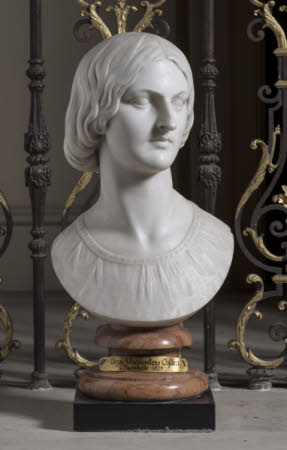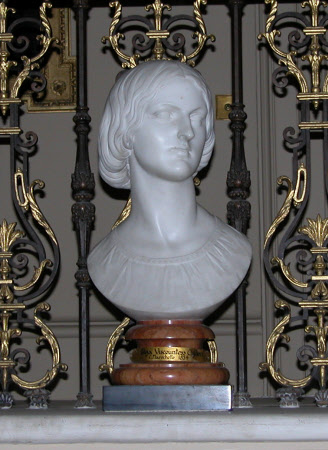Portrait bust of Eliza Horatia Frederica Seymour (1833-1896), later Viscountess Clifden and Lady Stirling
Baron Carlo Marochetti, RA (Turin 1805 – Passy, Paris 1867)
Category
Art / Sculpture
Date
1854
Materials
Marble
Measurements
60 x 32 cm
Place of origin
London
Order this imageCollection
Ickworth, Suffolk
NT 852222
Summary
Sculpture, marble; portrait bust of Eliza Horatia Frederica Seymour (1833-1896), later Viscountess Clifden and Lady Stirling; Carlo Marochetti (1805-1867); London, 1854. Eliza Seymour was the daughter of Lady Augusta Seymour (née Hervey, 1798-1880) and Frederick Seymour. This bust was commissioned from the successful Italian-born sculptor Carlo Marochetti, probably to mark Eliza’s coming of age on her 21st birthday. She would in 1861 marry Henry Agar-Ellis, 3rd Viscount Clifden of Gowran (1825-1866) and, subsequently, Sir Walter Stirling of Faskine, 3rd Bt. (1839-1934). Eliza Seymour is said to have been described by the diarist Henry Greville as ‘lovely to behold, full of grace and graciousness of demeanour.’.
Full description
A marble portrait bust of Eliza Horatia Frederica Seymour (1833-1896), later Viscountess Clifden and Lady Stirling, at the age of around 21. She is depicted with her head turned left, her thick hair parted at centre and pulled back and twisted into a knot at the nape of the neck. She wears a simple dress, with a collar stitched with a cross pattern. The bust section is rounded. Mounted on a turned pink granite socle. Signed and dated on the left truncation. The subject of this fine sculpted portrait, Eliza Horatia Frederica Seymour (1833-1896), was born on 16 July 1833, the eldest daughter of Lady Augusta Seymour (née Hervey, 1798-1880) and Frederick Seymour (1797-1856). In 1861, she married Henry Agar-Ellis, 3rd Viscount Clifden of Gowran (1825-1866), with whom she had three children. In 1875 Eliza married an army officer, Sir Walter Stirling of Faskine, 3rd Bt. (1839-1934), with whom she had two more children. She may have come to know Walter Stirling at court, as she served as a Lady of the Bedchamber to Queen Victoria between 1867 and 1872, whilst he was an Extra Groom-in-waiting to the Queen. Eliza Seymour was said to have been described by the diarist Henry Greville (]1801-1872) as ‘lovely to behold, full of grace and graciousness of demeanour.' The bust dated 1854, may possibly be identifiable with the ‘Marble bust of a lady’ exhibited by Marochetti at the Royal Academy summer exhibition in 1854 (no. 1441). It was probably commissioned to celebrate Eliza’s coming of age on her 21st birthday. There is also at Ickworth an oil painting by the French artist Claude Jacquand (1804-1878) depicting Eliza Seymour a little younger, at the age of around 19, in 1852 (NT 851736). From 1851 until her marriage in 1861, Eliza Seymour was active on the London social scene, a regular attendee at the annual party to celebrate Queen Victoria’s birthday, known as the Queen’s Drawing Room. Her marriage to Viscount Clifden took place on 23 September 1861 at St James’s Church, Piccadilly. Eliza Seymour‘s striking dark beauty was recognized from a young age, when she featured as one of twelve young ladies from the aristocracy in 'The Court Album' published in 1852, with illustrations based on portrait drawings by John Hayter (The Court Album. Twelve Portraits of the female Aristocracy, London 1852). An example of Hayter’s engraving of Eliza Seymour, updated for her marriage and change of title in 1861, is at Llanhydrock (NT 882230). Perhaps though the most original portrait known to have been made of Eliza Seymour was the photograph taken in 1861 by the French photographer Camille Silvy (1834-1910), who established a studio in London between 1858 and 1868. He produced a series of photographs of the three Seymour sisters as Virtues, Faith, Hope and Fortitude. Thus Eliza is seen grasping a sword in ‘Miss Eliza Seymour as Fortitude’ (examples in National Portrait Gallery, NPG Ax51955 and Ax51956), whilst her sisters personify two other virtues, Augusta Georgiana Sophia, Lady Charles Brudenell-Bruce (1834-1901) as Prudence, and Charlotte Seymour, Countess Spencer (1835-1903) as Faith. Although he is less well-known today, Carlo Marochetti was regarded by the mid-nineteenth century as one of the finest contemporary sculptors working in Europe. Born near Turin, he spent much of his childhood living with his family in Paris. His first triumph was his equestrian statue of Emmanuele Filiberto of Savoy, which was exhibited at the Louvre before being permanently installed in the Piazza San Carlo in Turin, in 1838. Marochetti moved to Britain after the revolution of 1848, quickly establishing himself as one of the country's leading sculptors, with commissions for major monuments such as the equestrian statue of Richard the Lionheart, the bronze version of which was installed outside the Palace of Westminster in 1860. His numerous other works included an equestrian statue of the Duke of Wellington for Glasgow, installed in 1844, whilst Marochetti also cast the massive bronze lions designed by Sir Edwin Landseer for the base of Nelson’s Column in Trafalgar Square. He also made numerous portraits and smaller monuments. Within National Trust collections, Marochetti is especially closely associated with William Bankes (1786-1855) and Kingston Lacy. Bankes came to know Marochetti in Paris in the 1830s and lobbied for the sculptor to receive his first significant commission in Britain, the equestrian monument of the Duke of Wellington for Glasgow. Bankes went on to commission a number of works from Marochetti for Kingston Lacy, notably three magnificent full-size bronze statues of King Charles I and Bankes’s ancestors and Royalist supporters, Sir John and Lady Bankes (NT 1255195.1-3). Jeremy Warren July 2025
Provenance
Part of the Bristol Collection. Acquired by the National Trust in 1956 under the auspices of the National Land Fund, later the National Heritage Memorial Fund.
Marks and inscriptions
On proper left truncation:: Marochetti 1854
Makers and roles
Baron Carlo Marochetti, RA (Turin 1805 – Passy, Paris 1867), sculptor
References
Roscoe 2009: I. Roscoe, E. Hardy and M. G. Sullivan, A Biographical Dictionary of Sculptors in Britain 1660-1851, New Haven and Yale 2009, p. 805, no. 84.

